Ladakh is a region in the Indian state of Jammu & Kashmir, famous for its incredible landscapes, mountain ranges, and high-altitude lakes. But Ladakh is not just about the natural beauty, it is also home to a diverse range of birds.
The region has a unique ecosystem that makes it a perfect habitat for a wide variety of bird species. With its extraordinary topography and its varied climate, Ladakh has something special for every bird enthusiast.
From the majestic Golden Eagles to the rare Black-necked cranes, from the small Rufous-backed Accentors to the Great Rosefinch, the birds of Ladakh are a wonder to behold.
In this article, we will explore the fascinating world of birds in Ladakh, their habitat, behavior, and conservation.
1. Black-Necked Crane
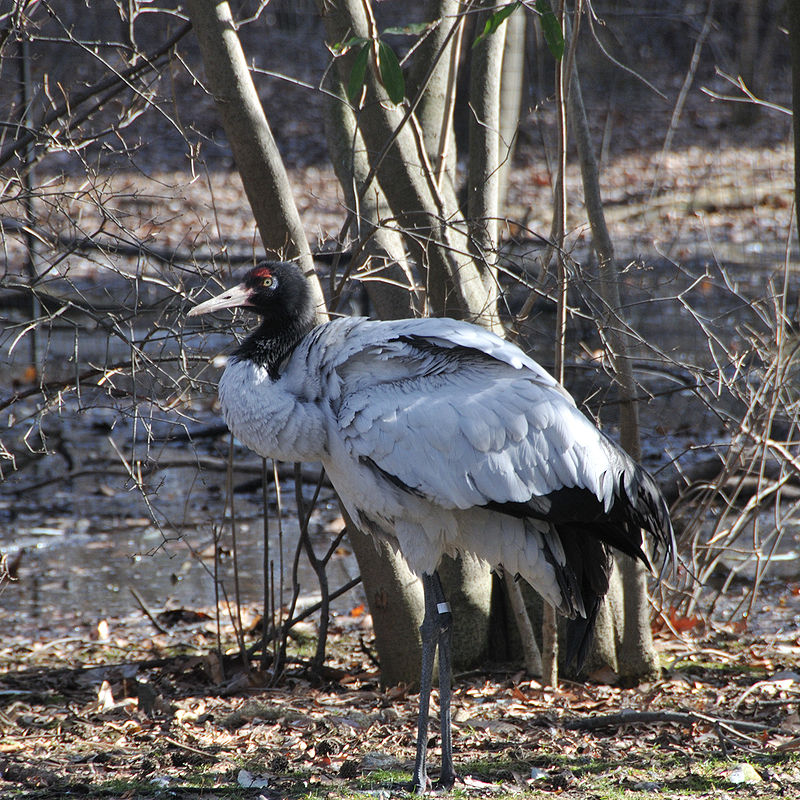
The Black-necked Crane is a majestic bird found in Asia. It has an impressive wingspan of 235cm and stands up to 139 cm tall.
Its feathers are whitish grey with beautiful black markings – head, neck and legs as well as the primaries and secondaries on its wings.
The white patch towards the back of its eye adds to their distinctiveness making them easily recognizable.
They can be seen flying gracefully over Tibet Plateau, India or Bhutan where they breed during summer months before migrating southwards for wintering grounds closer to sea level areas like Assam Valley in North East India.
Scientific classification:
| Kingdom | Animalia |
| Phylum | Chordata |
| Class | Aves |
| Order | Gruiformes |
| Family | Gruidae |
| Genus | Grus |
| Species | G. nigricollis |
Also Featured In: Common Birds in India, Asian Birds
2. Himalayan Snowcock
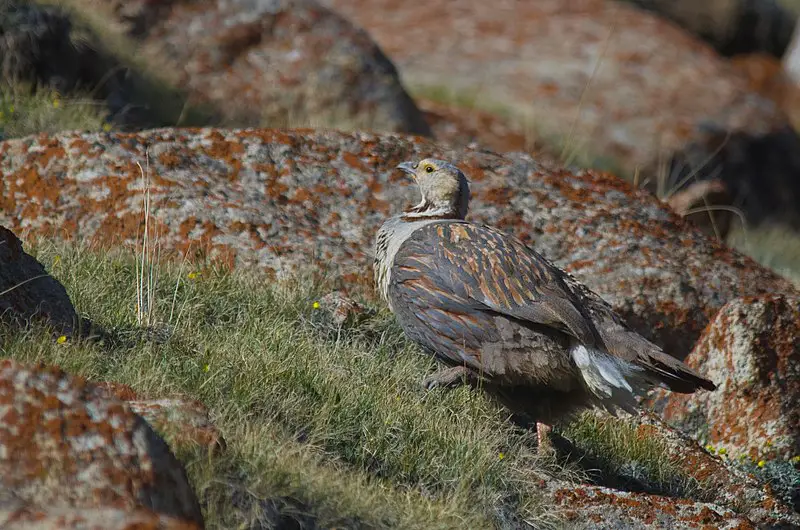
The Himalayan snowcock is a beautiful bird native to the remote, alpine regions of the Himalayas and Pamir range. They prefer rocky cliffs where they can dive into steep hill slopes for safety.
These birds are large in size compared to their closely related species, the Tibetan snowcock, with males reaching up to 25 inches long and weighing an average 2 pounds.
The plumage on these birds varies from grey-brown wings with white spotting along its backside and black barring on tail feathers; while underbelly feathers are bright rusty orange coloration.
Its diet consists primarily of plant matter such as seeds, grasses and flower buds found amongst rocks or high mountain meadows during summer months when it migrates higher up in altitude seeking cooler temperatures during hot season.
Scientific classification:
| Kingdom | Animalia |
| Phylum | Chordata |
| Class | Aves |
| Order | Galliformes |
| Family | Phasianidae |
| Genus | Tetraogallus |
| Species | T. himalayensis |
Also Featured In: Native Pakistani Birds,
3. Black Drongo

The Black Drongo is a small passerine bird of the Dicruridae family, commonly found in tropical southern Asia from Iran through India and Bangladesh to Indonesia.
It has an all black plumage and distinctive forked tail measuring 28 cm long. This omnivorous species feeds on insects such as flies, bees, beetles and moths; it also consumes fruit juices during summer months.
The nest can be built anywhere including open fields or near houses made up of twigs with a cup-shaped inner lining using grasses & hair filled with feathers & cobwebs.
During breeding season they are known to perform aerial acrobatics while chasing away any intruders who come too close to their nests.
Scientific classification:
| Kingdom | Animalia |
| Phylum | Chordata |
| Class | Aves |
| Order | Passeriformes |
| Family | Dicruridae |
| Genus | Dicrurus |
| Species | D. macrocercus |
Also Featured In: Most Common Types of Bangladeshi Birds, Most Common Taiwan Birds
4. Laughing Dove
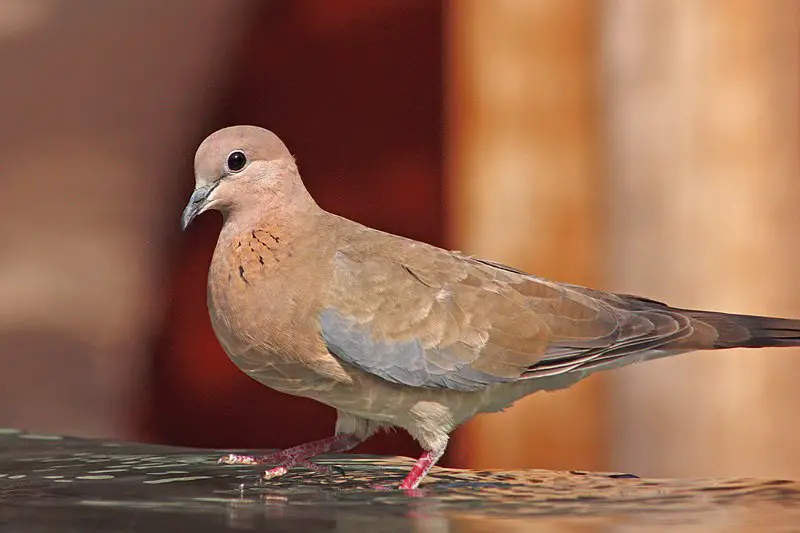
The Laughing Dove is a small and long-tailed pigeon found in dry, scrubby or semi-desert habitats. These birds are native to Africa, the Middle East, South Asia and Western Australia where they were released from Perth Zoo in 1898.
A unique feature of these doves is their call which sounds like low laughter – hence its name.
They form pairs when feeding on the ground, often near water sources such as pools or riverbanks. The diet of this bird consists mainly of seeds with some invertebrates also taking up part of it.
This species has adapted well to different environments due to its ability to find food resources easily even during times when other foods may be scarce.
Scientific classification:
| Kingdom | Animalia |
| Phylum | Chordata |
| Class | Aves |
| Order | Columbiformes |
| Family | Columbidae |
| Genus | Spilopelia |
| Species | S. senegalensis |
Also Featured In: Egyptian Birds, Most Common Western Australia Birds
5. Himalayan Vulture
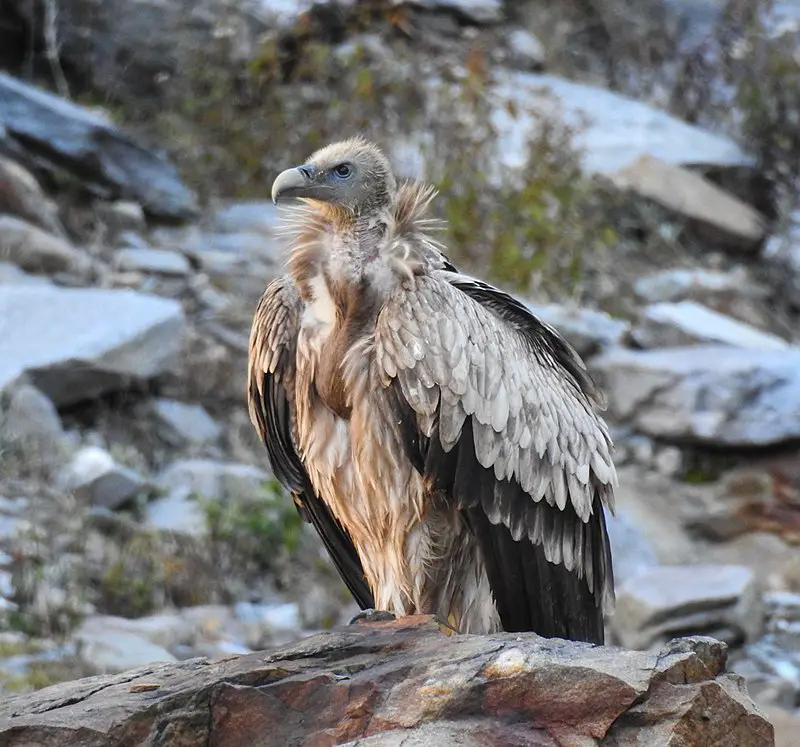
The Himalayan vulture is a majestic bird native to the Himalayas and Tibetan Plateau. It belongs to the Old World vultures, which are true raptors. With its dark brown plumage and large wingspan, it is one of two largest Old World species.
Sadly, it has been classified as Near Threatened on IUCN Red List due to loss of habitat caused by human activities such as deforestation and overgrazing in this area.
To prevent further population reduction for these birds, there needs to be increased conservation efforts that focus on protecting their natural habitats from destruction or harm so they can continue living undisturbed in their natural environment.
Scientific classification:
| Kingdom | Animalia |
| Phylum | Chordata |
| Class | Aves |
| Order | Accipitriformes |
| Family | Accipitridae |
| Genus | Gyps |
| Species | G. himalayensis |
Also Featured In: Birds of Thailand,
6. Brown Accentor
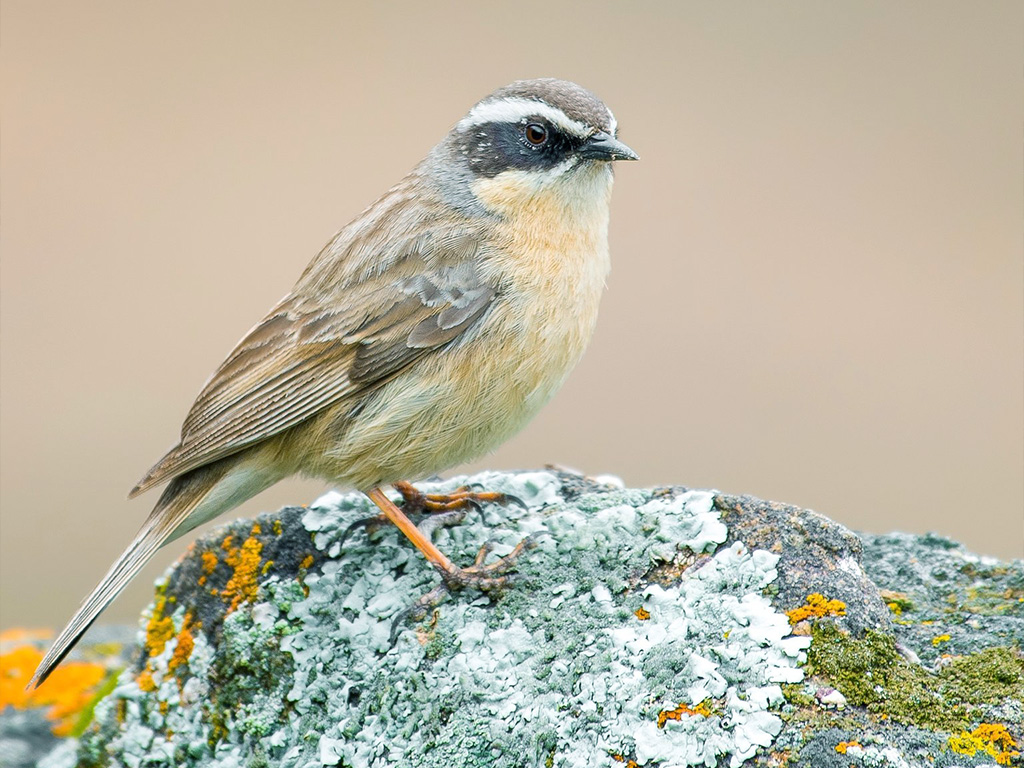
The Brown Accentor is a small bird native to parts of Central Asia and the Middle East. It belongs to the Prunellidae family, which includes some of Europe’s most common passerines.
This species has brown upperparts with lighter spots on its chest and back, while its head and throat are light greyish-white in coloration.
Its underparts are whitish or yellowish-buff that fades into a dark rusty hue at the tail tip.
The Brown Accentor feeds mainly on insects it finds foraging through ground vegetation like low shrubs or grasses but also eats seeds when available.
As such, it prefers dry Mediterranean habitats with sparsely vegetated areas where there is ample food availability throughout the year.
Though relatively widespread across much of their range due to an adaptable nature, this species can be threatened by habitat destruction caused by human activities such as agricultural expansion or urbanization
Scientific classification:
| Kingdom | Animalia |
| Phylum | Chordata |
| Class | Aves |
| Order | Passeriformes |
| Family | Prunellidae |
| Genus | Prunella |
| Species | P. fulvescens |
Also Featured In: Native Birds of Afghanistan,
7. Great Rosefinch
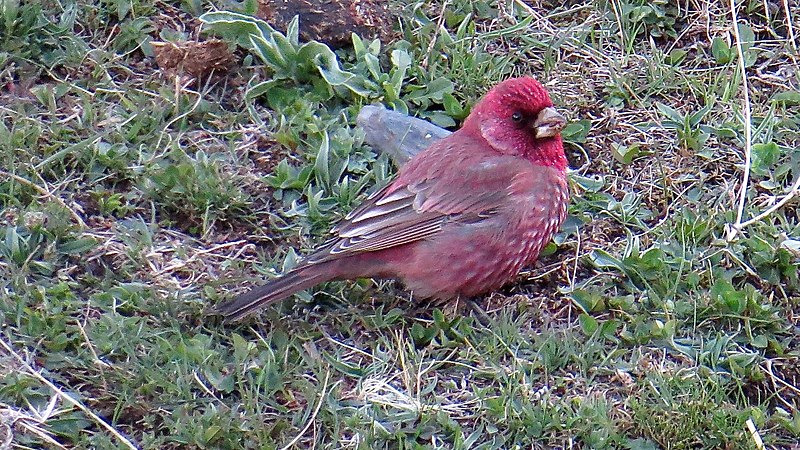
The Great Rosefinch is a small bird of the finch family found in parts of Central Asia. With its bright plumage and distinct song, it’s easy to spot amongst other birds in its habitat.
It has adapted well to living in tundra as well as temperate grassland environments across Afghanistan, Azerbaijan, Georgia, Iran and many more countries.
Historically three subspecies were treated separately but taxonomy now treats them all under one species – Carpodacus rubicilla.
Despite being relatively common they face potential threats from deforestation which could reduce their available habitats significantly over time if conservation measures are not taken seriously by local governments and NGOs alike.
Scientific classification:
| Kingdom | Animalia |
| Phylum | Chordata |
| Class | Aves |
| Order | Passeriformes |
| Family | Fringillidae |
| Subfamily | Carduelinae |
| Genus | Carpodacus |
| Species | C. rubicilla |
Also Featured In: Azerbaijan Birds,
8. Tibetan Sandgrouse
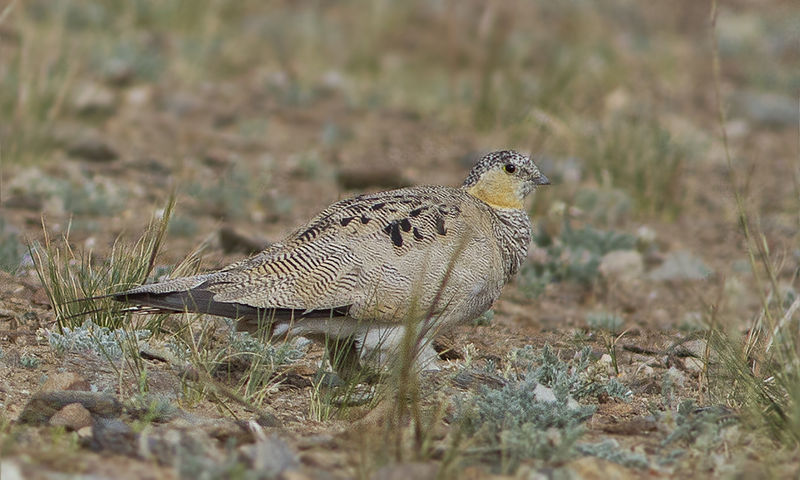
The Tibetan sandgrouse is a large bird in the sandgrouse family, measuring about 30-41 cm long. It has a small head and neck like a pigeon, but its body is quite sturdy and compact.
Its most distinct feature are its fused feathered toes which give it an appearance as if they had been sewn together–hence the genus name Syrrhaptes from Greek words meaning “sewn together”.
This species of bird inhabits Tibet, hence the specific epithet tibetanus.
The Tibetan Sand Grouse generally feeds on vegetation such as grass shoots or grains found on open plains near water sources; however during drought seasons they may travel up to several hundred kilometers for food and water.
Scientific classification:
| Kingdom | Animalia |
| Phylum | Chordata |
| Class | Aves |
| Order | Pterocliformes |
| Family | Pteroclidae |
| Genus | Syrrhaptes |
| Species | S. tibetanus |
Also Featured In: Most Common Birds in Tajikistan,
9. Brown-Headed Gull
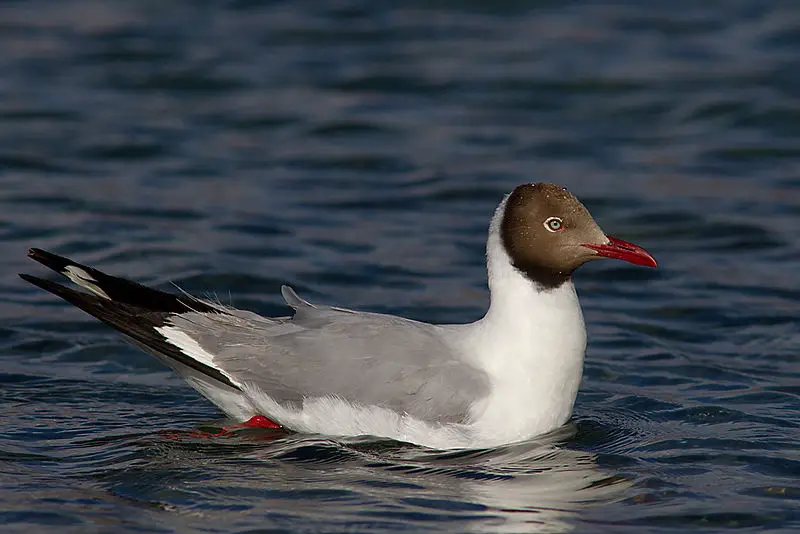
The Brown-headed Gull is a small species of gull that breeds in the high plateaus of Central Asia, from Tajikistan to Inner Mongolia.
During winter it migrates southward and can be seen along coastal areas and large inland lakes throughout the Indian Subcontinent.
They usually breed in colonies within reedbeds or marshes, constructing nests out of sticks on top of trees or among tall vegetation.
These birds have brown heads while their bodies are white with black wing tips; they also feature bright yellow eyes which give them an intense yet endearing look.
Their diet consists mainly fish but they’ll also consume insects, molluscs, crustaceans as well as other invertebrates and even plant matter during seasons when food is scarce.
Despite their shy nature towards humans these amazing birds make for wonderful wildlife watching opportunities.
Scientific classification:
| Kingdom | Animalia |
| Phylum | Chordata |
| Class | Aves |
| Order | Charadriiformes |
| Family | Laridae |
| Genus | Chroicocephalus |
| Species | C. brunnicephalus |
Also Featured In: Birds of Goa, Common Birds of Maharashtra
10. Tibetan Snowcock
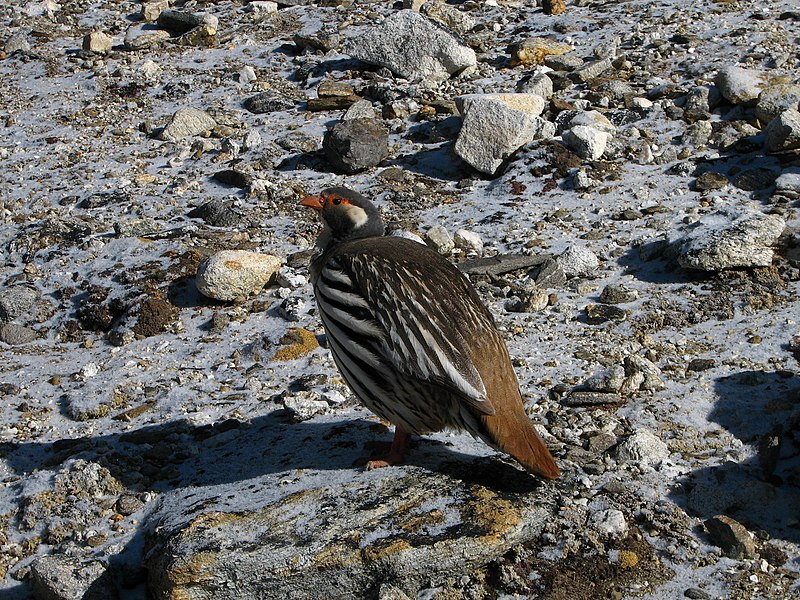
The Tibetan snowcock is a bird from the pheasant family, found in high-altitude regions of the Western Himalayas and Tibetan Plateau. It has a greyish head with a white crescent patch behind its eye.
The underside of it is white but marked by black barring along its sides and breast which gives this species an unmistakable look.
In size they are smaller than their counterpart,the larger Himalayan snowcock; generally measuring between 32 – 37 cm long with males being slightly bigger than females.
They feed mainly on grasses, grains and other seeds as well as buds during summertime while insects become more important during winter months when food sources are scarce due to harsh weather conditions that exist at such altitudes
Scientific classification:
| Kingdom | Animalia |
| Phylum | Chordata |
| Class | Aves |
| Order | Galliformes |
| Family | Phasianidae |
| Genus | Tetraogallus |
| Species | T. tibetanus |
11. Güldenstädt’s Redstart
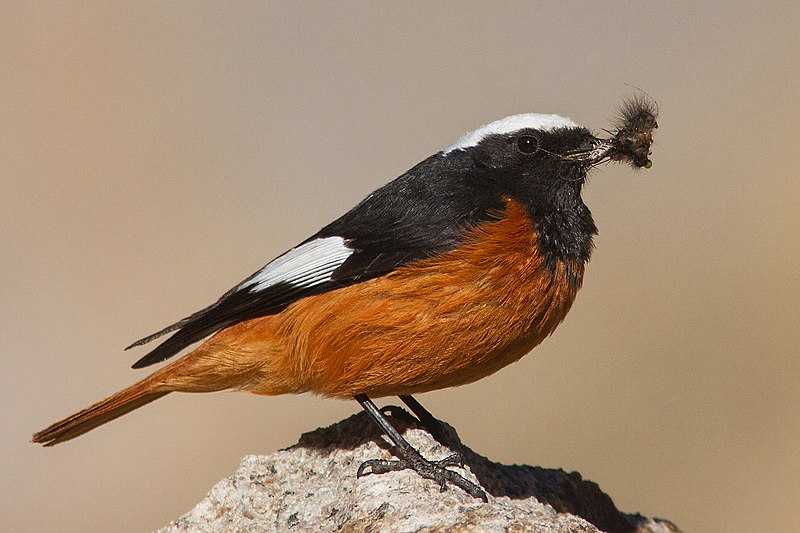
Güldenstädt’s redstart, also known as the white-winged redstart, is a species of bird in the Muscicapidae family. It can be found in the high mountains of southwestern and central Palearctic regions such as Caucasus, Karakoram, Pamir, Himalaya ,Tian Shan and Altai.
The countries where it can be seen are Afghanistan , Armenia , Azerbaijan , Bhutan China Georgia India Iran Kazakhstan Kyrgyzstan Mongolia Nepal Pakistan Tajikistan Turkmenistan Uzbekistan and parts of Russia.
This small passerine has greyish upperparts with some reddish tints on its wings that give it its name.
Its underparts are mainly rusty orange to pink with a dark tail tip that distinguishes this bird from other species belonging to same genus Phoenicurus.
As an insectivore Güldenstädt’s Redstart feeds mostly on insects like flies spiders moths bees ants etc which form most part of their diet during summer months but eats fruits berries during winter season too .
Scientific classification:
| Kingdom | Animalia |
| Phylum | Chordata |
| Class | Aves |
| Order | Passeriformes |
| Family | Muscicapidae |
| Genus | Phoenicurus |
| Species | P. erythrogastrus |
12. Plumbeous Water Redstart
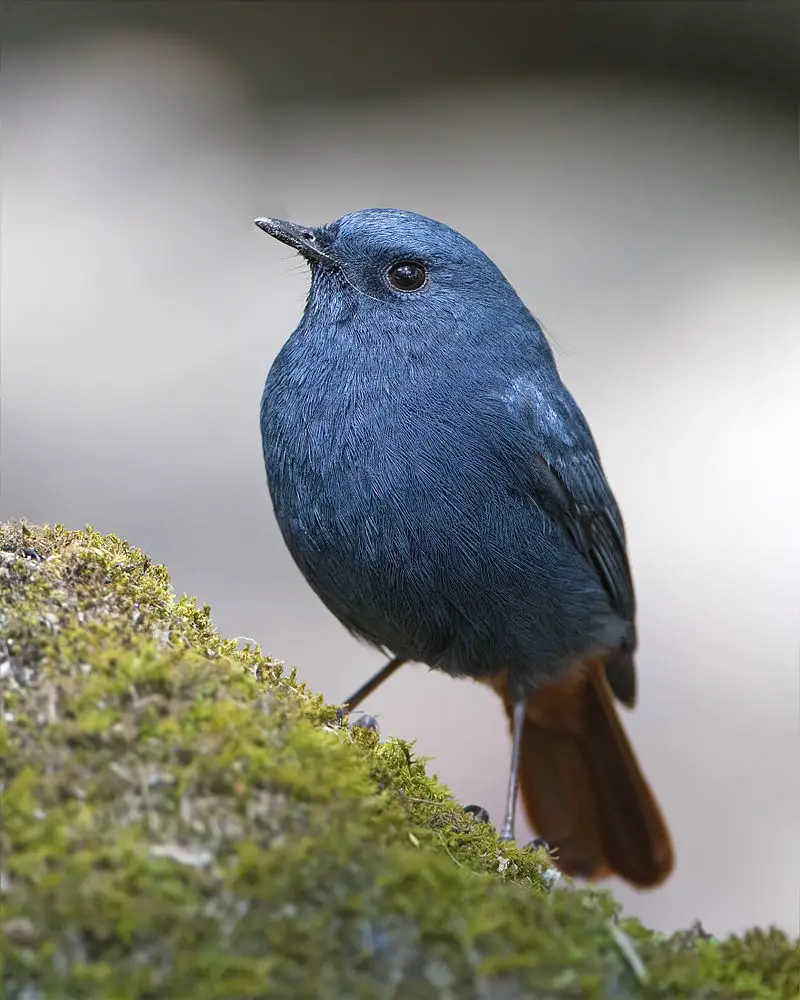
The Plumbeous Water Redstart is a beautiful passerine bird belonging to the Old World Flycatcher family. It can be found in South Asia, Southeast Asia and China, usually near fast-moving streams or rivers.
Males are slate blue while females have gray plumage with a slight reddish tinge on their wings. They also possess short tails and long legs which help them move swiftly over rocks by the water’s edge.
The name of this species comes from its lead-like colouring – ‘plumbeus’ meaning leaden in Latin.
These birds typically feed on insects such as grasshoppers, beetles and caterpillars that they catch by darting out from perches amongst boulders along streamsides or across roads like little flashes of lightening.
Scientific classification:
| Kingdom | Animalia |
| Phylum | Chordata |
| Class | Aves |
| Order | Passeriformes |
| Family | Muscicapidae |
| Genus | Phoenicurus |
| Species | P. fuliginosus |
13. Snow Pigeon
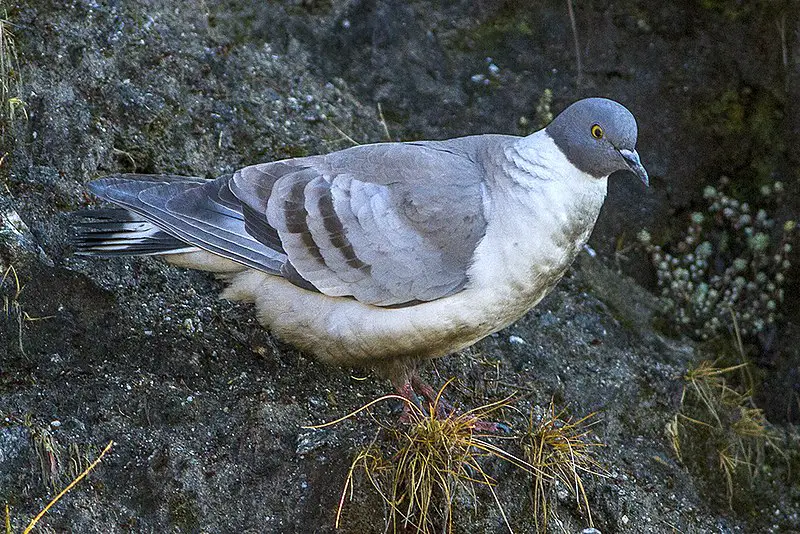
The snow pigeon is a species of bird found in hilly regions of Central Asia. It has various colors such as grey, black, pale brown and white with two subspecies recognised.
The western Himalayas from Western Afghanistan to Sikkim are the home for C. l. leuconota while C. l gradaria lives in eastern Tibet and Eastern Nan Shan (Qinghai).
These birds inhabit open grasslands or scrub forests where they feed on grains and seeds by walking along the ground like most other pigeons do.
They also take insects when available through out their range during summer months due to its catholic diet habits it can survive hostile conditions easily which makes them quite hardy species.
Scientific classification:
| Kingdom | Animalia |
| Phylum | Chordata |
| Class | Aves |
| Order | Columbiformes |
| Family | Columbidae |
| Genus | Columba |
| Species | C. leuconota |
Also Featured In: Kyrgyzstan Birds,
14. Red-Fronted Serin
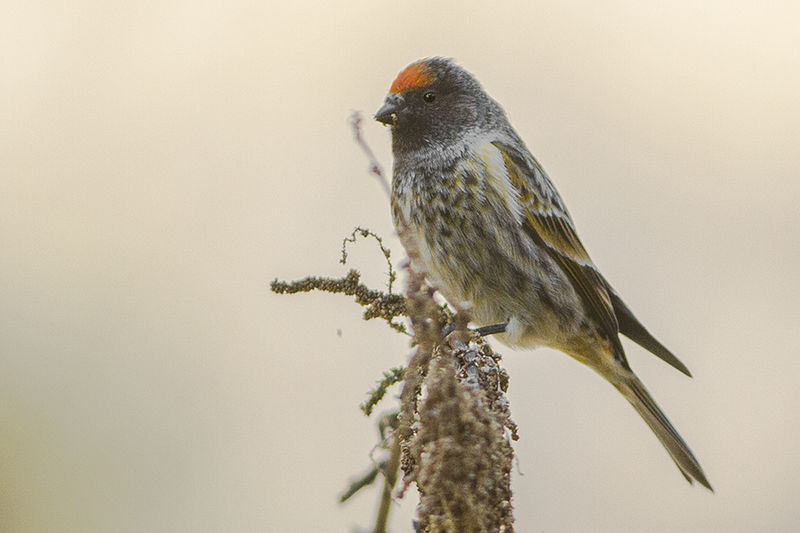
The Red-fronted serin, also known as the fire-fronted serin, is a tiny passerine bird belonging to the finch family. It has a preference for mountainous regions and typically grows up to 11-12 cm in length.
This bird can be found breeding in areas such as the Caucasus, Turkey, and Iran, with rare sightings of it reaching the Greek Eastern Aegean Islands during winter. Apart from this, the Red-fronted serin can also be found in the Ladakh region of India.
With its striking red front, this bird is a sight to behold in its natural habitat.
Scientific classification:
| Kingdom | Animalia |
| Phylum | Chordata |
| Class | Aves |
| Order | Passeriformes |
| Family | Fringillidae |
| Subfamily | Carduelinae |
| Genus | Serinus |
| Species | S. pusillus |
Also Featured In: Birds That Live in Iraq, Common Uzbekistan Birds
15. Rufous-Naped Tit
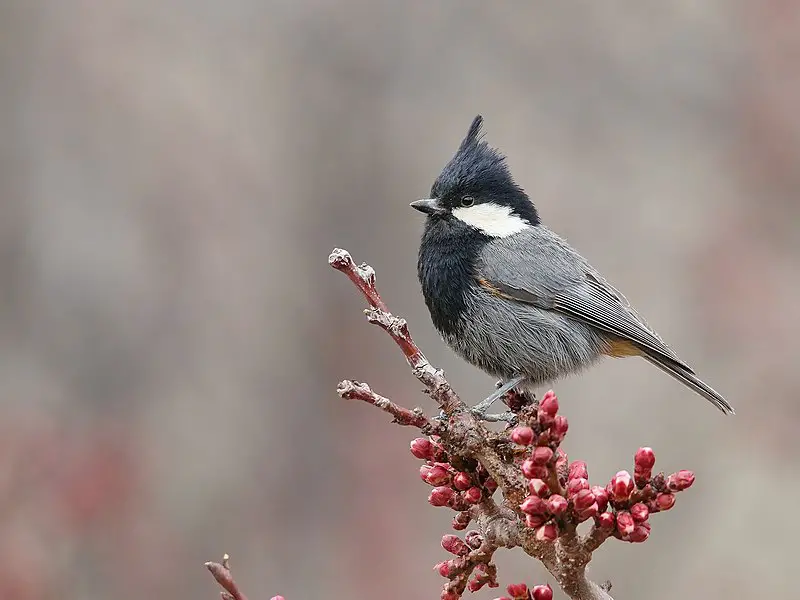
The Rufous-naped tit or black-breasted tit, a member of the Paridae family, is a songbird species found mainly in the western Himalayas.
With a wide-ranging habitat, it was previously placed under Parus genus and often considered as conspecific with the Rufous-vented tit or P. rubidiventris.
These small, dark-grey or black-breasted birds are known for their distinct reddish-brown nape and can be seen flitting through the forests, gardens, and shrubby areas in search of insects and berries.
Their natural habitats include the pine and oak forests at elevations of 2000-4600 meters.
The Rufous-naped tit is an essential part of the Himalayan ecosystem, where it plays a vital role in seed dispersal and pest control.
Scientific classification:
| Kingdom | Animalia |
| Phylum | Chordata |
| Class | Aves |
| Order | Passeriformes |
| Family | Paridae |
| Genus | Periparus |
| Species | P. rufonuchalis |
16. Citrine Wagtail
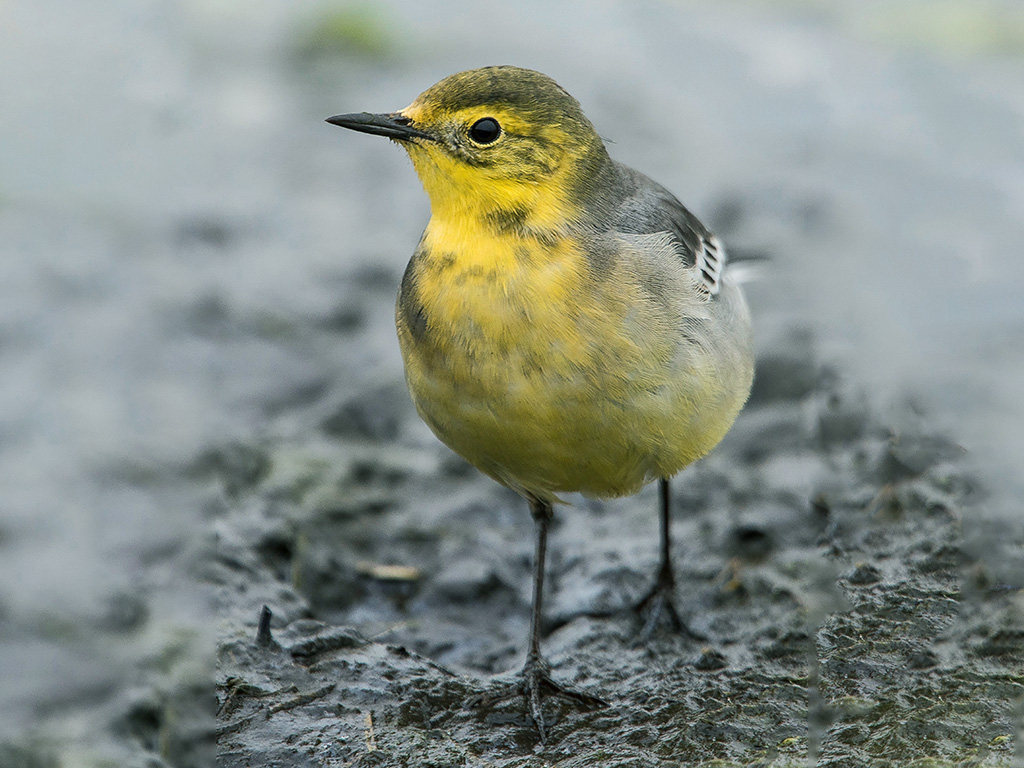
The citrine wagtail is a petite songbird that belongs to the Motacillidae family. Its yellowish hue, as denoted by its name, adds flashes of brightness to its appearance.
In the early 21st century, there has been much discussion surrounding its systematics, taxonomy, and phylogeny as it forms a cryptic species complex with the eastern and western yellow wagtail.
Scientific classification:
| Kingdom | Animalia |
| Phylum | Chordata |
| Class | Aves |
| Order | Passeriformes |
| Family | Motacillidae |
| Genus | Motacilla |
| Species | M. citreola |
Also Featured In: Armenian Birds You Should Know, Most Common Lithuanian Birds
17. Twite
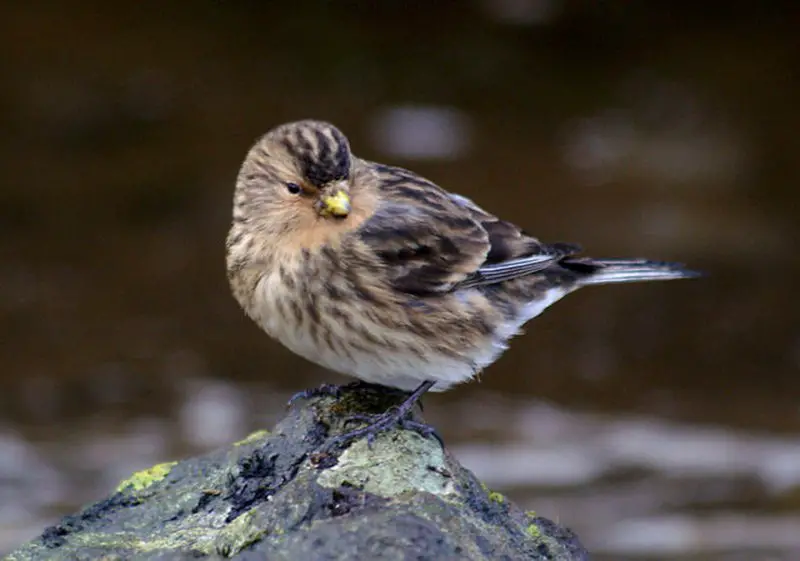
The Twite bird is a small brown passerine bird belonging to the finch family. It is similar in size and shape to a linnet bird.
However, it lacks the red head patch and breast shown by the linnet and the redpolls.
The Twite bird is brown streaked with black above and has a pink rump. The bird’s underparts are buff to whitish, streaked with brown.
The conical bill of the bird is yellow in color. The Twite bird is approximately 13 to 13.5 cm in length.
Scientific classification:
| Kingdom | Animalia |
| Phylum | Chordata |
| Class | Aves |
| Order | Passeriformes |
| Family | Fringillidae |
| Subfamily | Carduelinae |
| Genus | Linaria |
| Species | L. flavirostris |
Also Featured In: Shetland Islands Birds You Should Know,
18. Sulphur-Bellied Warbler
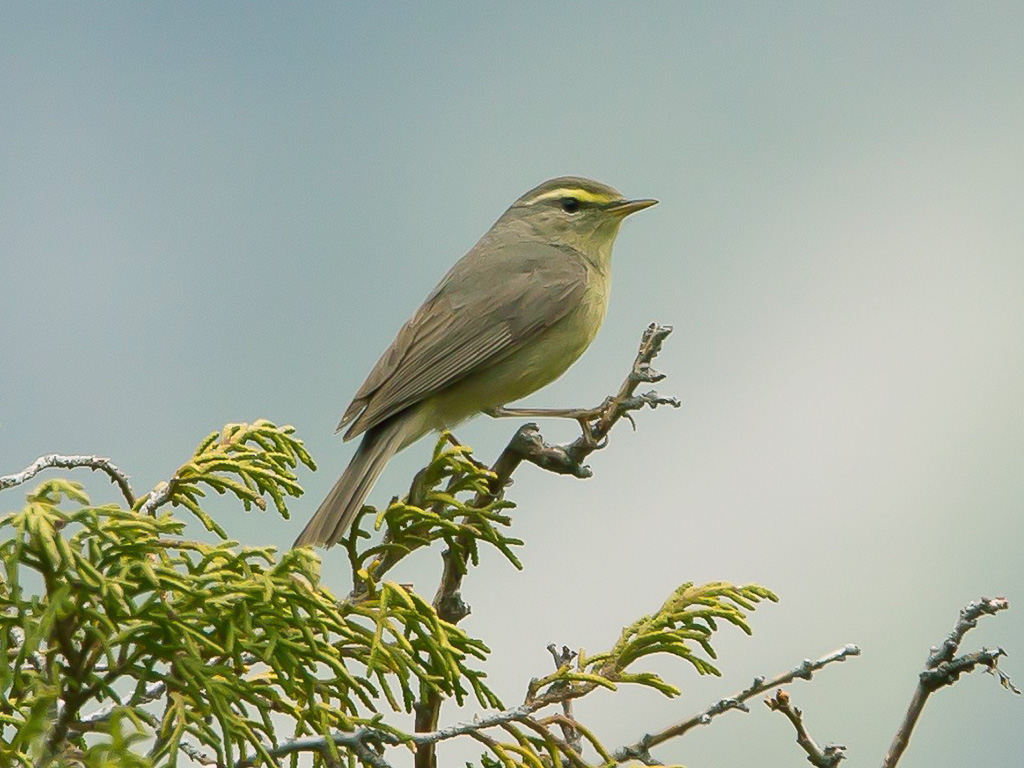
The sulphur-bellied warbler, also known as the olivaceous leaf-warbler, is a small bird found in the Palearctic region. It is commonly seen in Afghanistan, Kazakhstan, Kyrgyzstan, Mongolia, Russian Federation, Tajikistan, and Turkmenistan.
This species of leaf-warbler feeds on insects and can be found in rocky hillsides. It is known for its distinctive yellow underbelly and brownish-green feathers. Like other leaf-warblers, it feeds by gleaning small branches and leaves.
Despite its small size, the sulphur-bellied warbler is an essential part of the ecosystem and plays an important role in the food chain.
Conservation efforts must be made to protect this beautiful and unique bird.
Scientific classification:
| Kingdom | Animalia |
| Phylum | Chordata |
| Class | Aves |
| Order | Passeriformes |
| Family | Phylloscopidae |
| Genus | Phylloscopus |
| Species | P. griseolus |
Also Featured In: Gujarati Birds, Common Birds in Bangalore
19. Rusty-Tailed Flycatcher
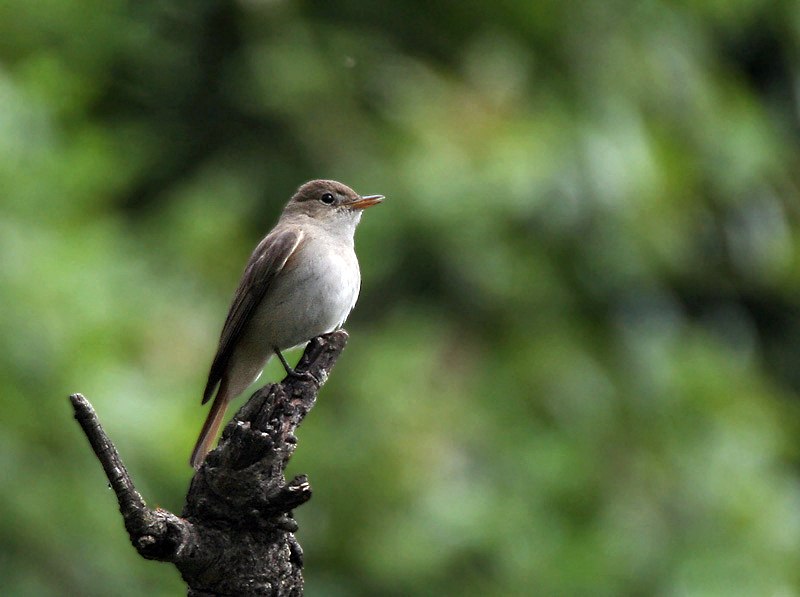
The Rusty-tailed flycatcher is a small bird that belongs to the Muscicapidae family. It inhabits the northern regions of the Indian Subcontinent and some parts of southwest India, as well as Uzbekistan and Tajikistan.
This species is partially migratory, with populations from Central Asia traveling to India during the winter months.
The bird is characterized by its rusty-colored tail feathers and has a unique song that distinguishes it from other flycatchers.
Despite being a small bird, the Rusty-tailed flycatcher is an efficient hunter and feeds mainly on insects caught in mid-air.
Overall, this small bird can be considered an extraordinary and important part of the diverse bird species found in this region of the world.
Scientific classification:
| Kingdom | Animalia |
| Phylum | Chordata |
| Class | Aves |
| Order | Passeriformes |
| Family | Muscicapidae |
| Genus | Ficedula |
| Species | F. ruficauda |
20. Tickell’s Leaf Warbler
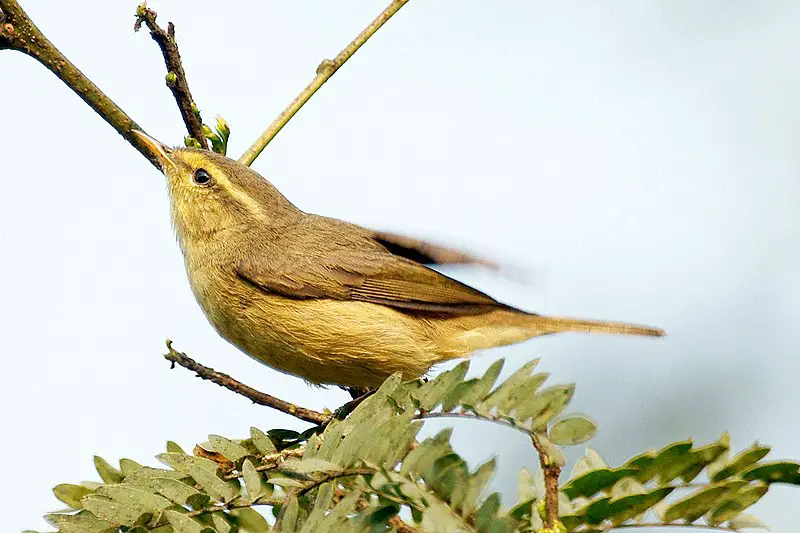
Tickell’s leaf warbler is a small migratory bird found in several Asian countries including Bangladesh, Bhutan, China, India, Myanmar, Nepal, Pakistan, and Thailand.
This bird has yellowish underparts and a distinct supercilium. It feeds mainly on insects and catches them by short sallies or gleaning. The bird is highly active and commonly seen in the canopy and low shrubbery.
It can be difficult to track or spot. The Tickell’s leaf warbler is a beautiful bird with an active lifestyle that adds to the diversity of birds found in Asia.
Scientific classification:
| Kingdom | Animalia |
| Phylum | Chordata |
| Class | Aves |
| Order | Passeriformes |
| Family | Phylloscopidae |
| Genus | Phylloscopus |
| Species | P. affinis |
21. Ground Tit
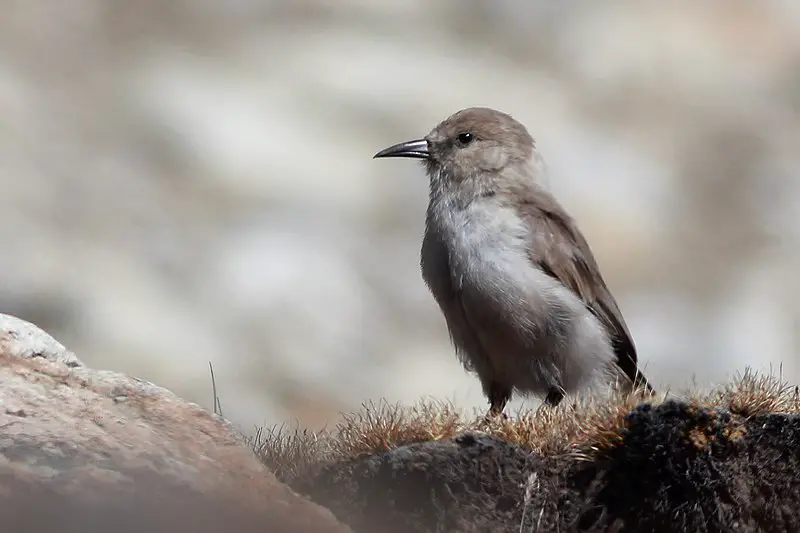
The Ground Tit bird is a unique species found in the Tibetan plateau. Its appearance has confused ornithologists in the past, with some mistaking it for a groundpecker or ground jay.
However, it actually belongs to its own family, known as Pseudopodocidae. Despite its small size, the Ground Tit has adapted to survive the harsh conditions of the plateau, including extreme temperatures and high altitudes.
Its diet consists mainly of insects, which it hunts on the ground, and it is known for its distinctive call.
Due to its limited range and low population, the Ground Tit is considered a vulnerable species and is currently threatened by habitat loss and degradation.
Scientific classification:
| Kingdom | Animalia |
| Phylum | Chordata |
| Class | Aves |
| Order | Passeriformes |
| Family | Paridae |
| Genus | Pseudopodoces Zarudny & Loudon, 1902 |
| Species | P. humilis |
22. Black-Winged Snowfinch
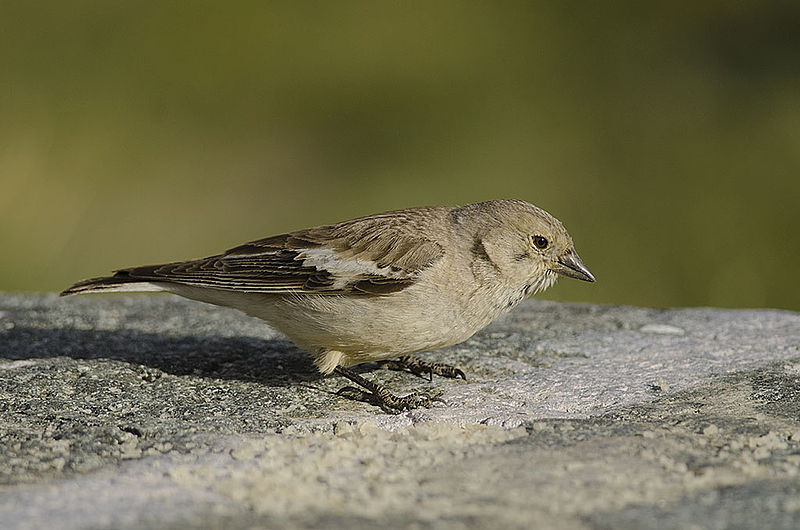
The Black-winged snowfinch, also known as Adams’s snowfinch, is a type of bird that belongs to the sparrow family. It can be found in several countries including China, India, Nepal, and Pakistan.
This bird prefers a habitat that is subtropical or tropical dry shrubland. It is commonly found in the Tibetan plateau region of north-western Nepal where it resides during the summer months at elevations ranging from 4,200 to 5,100 meters.
The Black-winged snowfinch is a beautiful bird with predominantly white feathers and black wings. Its diet consists of insects and seeds.
Due to its unique features, this beautiful bird is a favorite among birdwatchers who seek to observe and appreciate the beauty of the natural world.
Scientific classification:
| Kingdom | Animalia |
| Phylum | Chordata |
| Class | Aves |
| Order | Passeriformes |
| Family | Passeridae |
| Genus | Montifringilla |
| Species | M. adamsi |
23. Tibetan Partridge
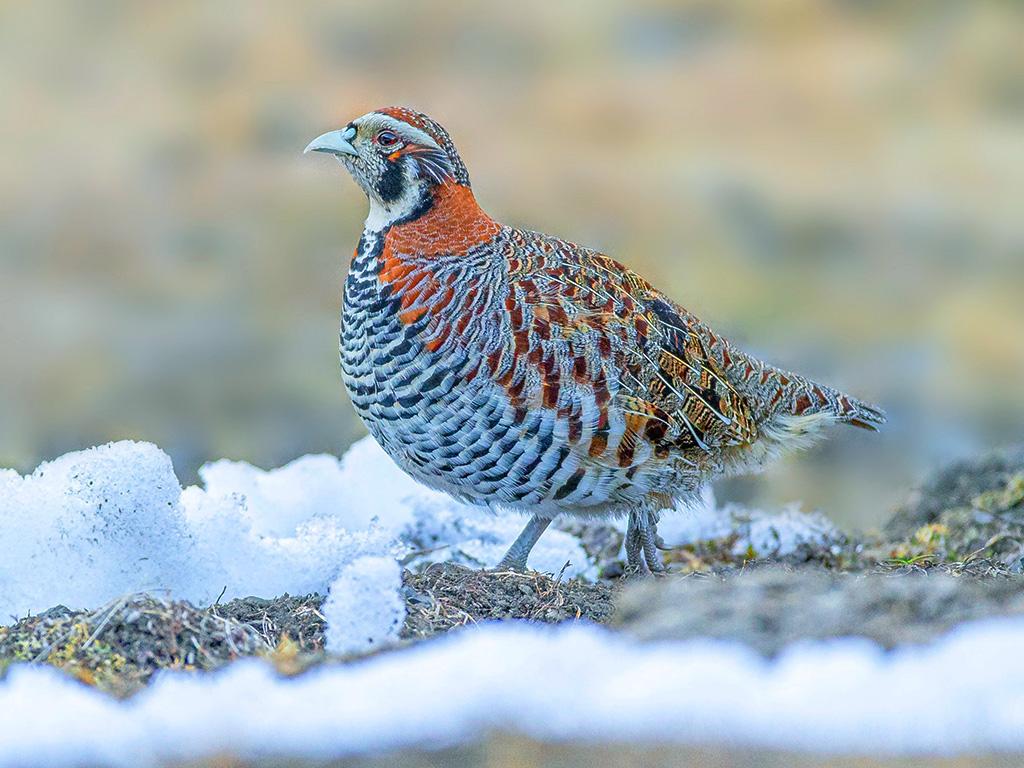
The Tibetan partridge is a gamebird found across the Tibetan Plateau. Variations in plumage can be seen among different populations.
They forage on the ground in sparsely vegetated high altitude regions, moving in pairs during the summer and in larger groups during the non-breeding season.
Both males and females do not have any remarkable distinctions.
Scientific classification:
| Kingdom | Animalia |
| Phylum | Chordata |
| Class | Aves |
| Order | Galliformes |
| Family | Phasianidae |
| Genus | Perdix |
| Species | P. hodgsoniae |
24. Robin Accentor
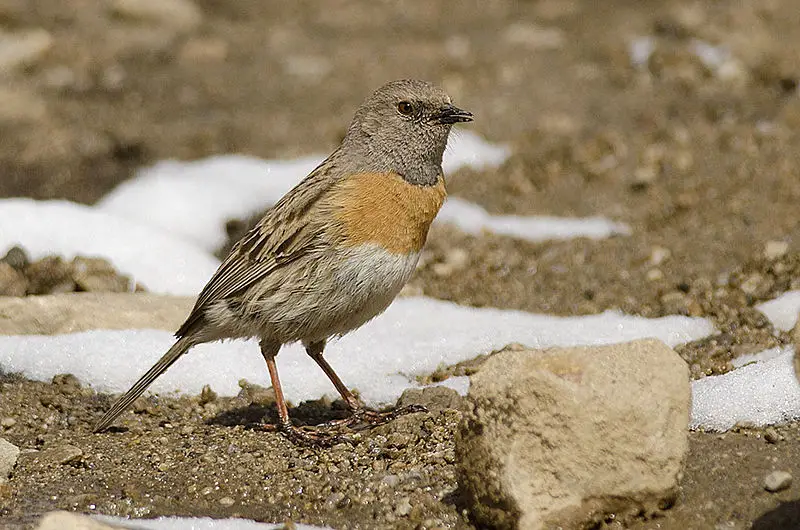
The Robin Accentor is a bird that belongs to the Prunellidae family. It is commonly found in mountainous regions of Afghanistan, China, Bhutan, India, Nepal, and Pakistan at altitudes of around 3,000 to 5,500 meters above sea level.
This brown bird has a grey head and a bright orange-red breast. It is a species that is fairly abundant in some parts of its habitat. Despite this, its conservation status has been assessed.
Scientific classification:
| Kingdom | Animalia |
| Phylum | Chordata |
| Class | Aves |
| Order | Passeriformes |
| Family | Prunellidae |
| Genus | Prunella |
| Species | P. rubeculoides |
25. Mongolian Finch
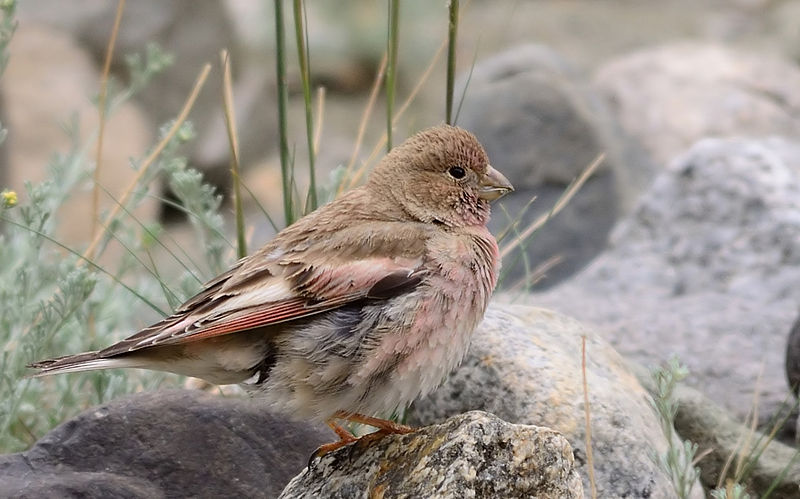
The Mongolian finch, also called the Mongolian trumpeter finch, is a small bird belonging to the finch family. It has long wings and a big head with a short, thick yellowish-grey beak.
During breeding season, male Mongolian finches display a pinkish tinge on their faces and underparts. Their wings are also adorned with white and pink patches. Despite its small size, this bird can travel long distances.
It is a fascinating creature to observe in the wild due to its distinct physical features and unique behavior. If you happen to come across a Mongolian finch, be sure to take a moment to appreciate the beauty of this small but magnificent bird.
Scientific classification:
| Kingdom | Animalia |
| Phylum | Chordata |
| Class | Aves |
| Order | Passeriformes |
| Family | Fringillidae |
| Subfamily | Carduelinae |
| Genus | Bucanetes |
| Species | B. mongolicus |
26. Blanford’s Snowfinch
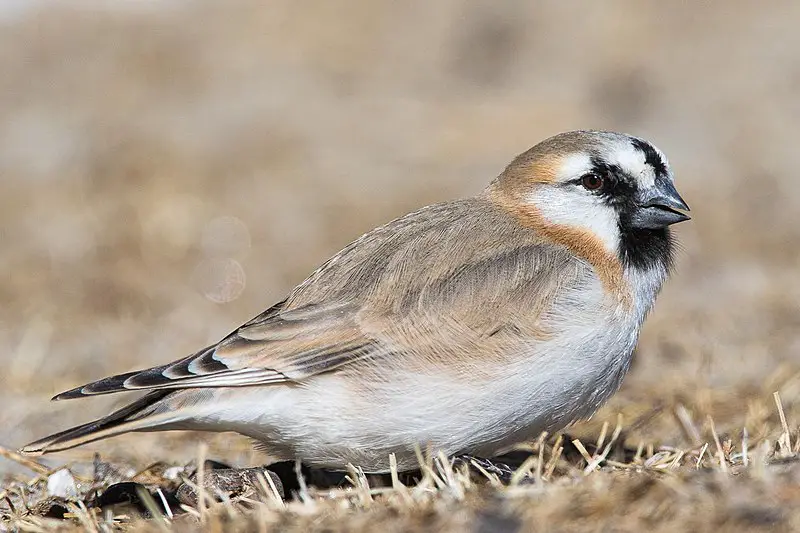
Blanford’s snowfinch, also known as the plain-backed snowfinch, is a bird species in the sparrow family found in China, India, Nepal, and Pakistan. They inhabit temperate grassland habitats.
This bird is named after the English zoologist William Thomas Blanford, and its species epithet is blanfordi. This bird is known for its distinctive plain back, which sets it apart from other snowfinches.
As a member of the sparrow family, it likely feeds on seeds and insects. Overall, Blanford’s snowfinch is a fascinating bird species found in the grasslands of central Asia.
Scientific classification:
| Kingdom | Animalia |
| Phylum | Chordata |
| Class | Aves |
| Order | Passeriformes |
| Family | Passeridae |
| Genus | Pyrgilauda |
| Species | P. blanfordi |
27. Streaked Rosefinch
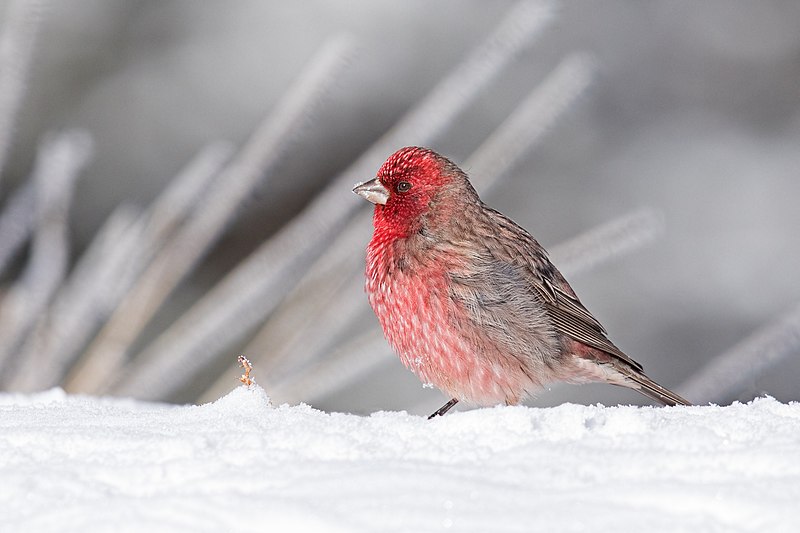
The streaked rosefinch, a member of the finch family, is a Himalayan bird found in boreal shrublands. It has two recognized subspecies. The bird is commonly seen in the Himalayan Plateau region.
It boasts beautiful streaked plumage set against a brownish background. The bird is known for its cheerful, melodious song that can be heard even in winter.
Despite the harsh conditions of its habitat, the streaked rosefinch manages to thrive in the region.
While it is not currently considered endangered, its unique environment and habitat may make it vulnerable to future changes.
Nonetheless, the streaked rosefinch remains a fascinating and beautiful part of the rich avian diversity of the Himalayan region.
Scientific classification:
| Kingdom | Animalia |
| Phylum | Chordata |
| Class | Aves |
| Order | Passeriformes |
| Family | Fringillidae |
| Subfamily | Carduelinae |
| Genus | Carpodacus |
| Species | C. rubicilloides |
28. Plain Mountain Finch
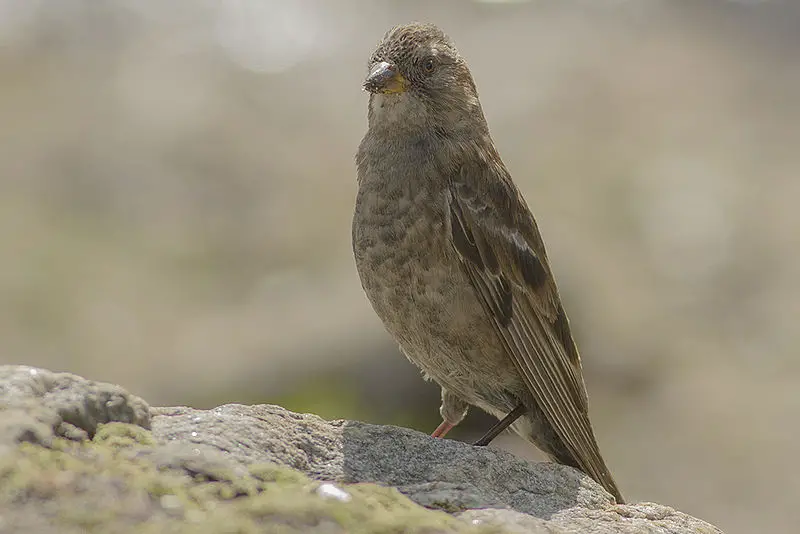
The Plain mountain finch is a member of the Finch family found in various countries, including Afghanistan, India, and Russia. It prefers living in temperate grasslands and upland forests across the Himalayas.
This resident breeder has adapted to its environment and can survive in harsh winters. With a plain appearance, the bird has a soft side, chirping melodiously in the morning hours.
Although not much is known about its diet, the Plain mountain finch is assumed to feed on seeds and insects.
Despite its wide distribution, the species faces threats due to habitat loss, pesticide use, and hunting. Conservation efforts are necessary to protect the Plain mountain finch and other wildlife in its habitat.
Scientific classification:
| Kingdom | Animalia |
| Phylum | Chordata |
| Class | Aves |
| Order | Passeriformes |
| Family | Fringillidae |
| Subfamily | Carduelinae |
| Genus | Leucosticte |
| Species | L. nemoricola |
29. Hume’s Short-Toed Lark
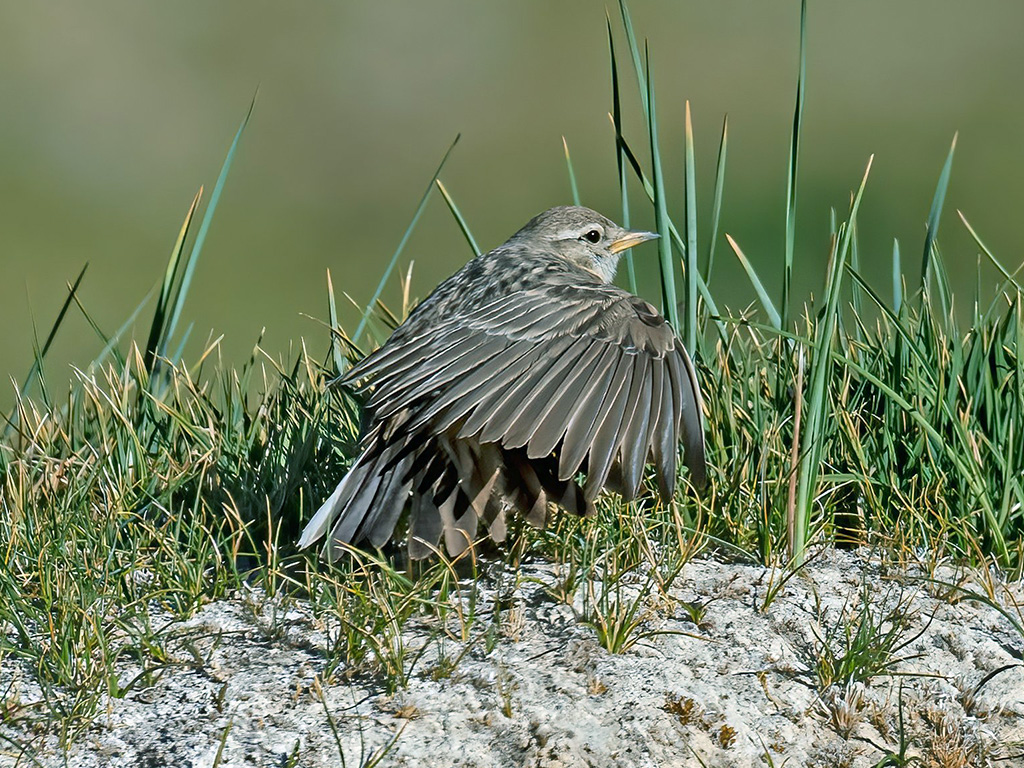
Hume’s short-toed lark, also known as the lesser short-toed lark, is a small bird belonging to the Alaudidae family. This species is native to south-central Asia, with a range that extends from Iran and Kazakhstan to China.
The bird’s name was given in honor of the British naturalist Allan Octavian Hume, who first described the species. The Hume’s short-toed lark has a distinctive beak that is sharp and pointed, hence the name.
Despite its small size, this bird is known for its powerful voice and can often be heard singing from the tops of bushes or other elevated perches.
Along with its alternate name, the lesser short-toed lark, this bird is sometimes confused with three other species in the Calandrella genus.
Scientific classification:
| Kingdom | Animalia |
| Phylum | Chordata |
| Class | Aves |
| Order | Passeriformes |
| Family | Alaudidae |
| Genus | Calandrella |
| Species | C. acutirostris |
30. Mountain Chiffchaff
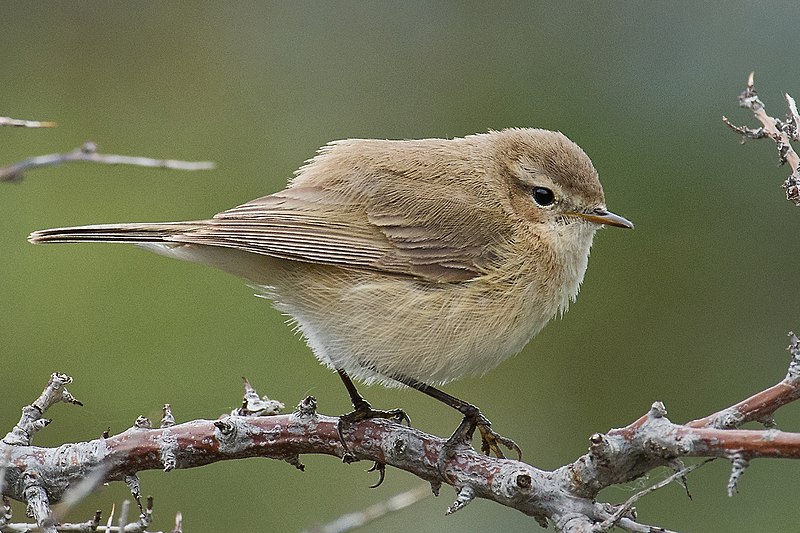
The mountain chiffchaff, also known as the eastern chiffchaff, is a type of leaf warbler that migrates from higher altitudes to lower levels in the winter.
It can be found in the Himalayas and the Caucasus, with distinct subspecies in each area. The nominate subspecies is similar to the Siberian chiffchaff, but has a finer and darker bill, as well as browner upperparts and buff flanks.
Notably, the mountain chiffchaff’s song is almost identical to that of the Siberian chiffchaff. As a migratory bird, the mountain chiffchaff demonstrates an important behavior for maintaining healthy ecosystems and adapting to changing environmental conditions.
Scientific classification:
| Kingdom | Animalia |
| Phylum | Chordata |
| Class | Aves |
| Order | Passeriformes |
| Family | Phylloscopidae |
| Genus | Phylloscopus |
| Species | P. sindianus |
31. Brown Dipper
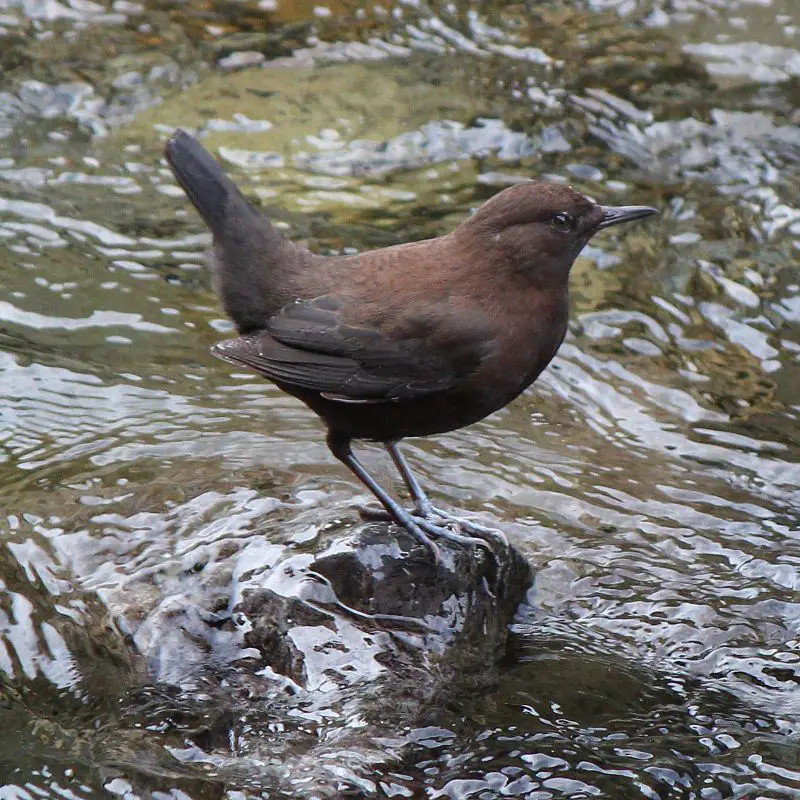
The Brown dipper bird is a songbird commonly found in the mountains of the east Palearctic. With its chocolate-brown plumage, it resembles a thrush and has a slightly lighter coloured back and breast.
This species is also known as Pallas’s dipper, Asian dipper, or Asiatic dipper. It has a cocked tail and is considered the largest of the dippers, measuring around 22 cm and weighing 87 g. Despite its size, this bird is an adept swimmer and is well equipped for aquatic life.
The Brown dipper’s natural habitat includes mountain streams and fast-flowing rivers. It is an aviary marvel to behold when navigating and diving along the water’s surface.
Scientific classification:
| Kingdom | Animalia |
| Phylum | Chordata |
| Class | Aves |
| Order | Passeriformes |
| Family | Cinclidae |
| Genus | Cinclus |
| Species | C. pallasii |
Also Featured In: Common Birds of Sapporo, Birds Commonly Found in Kyoto
32. Brandt’s Mountain Finch
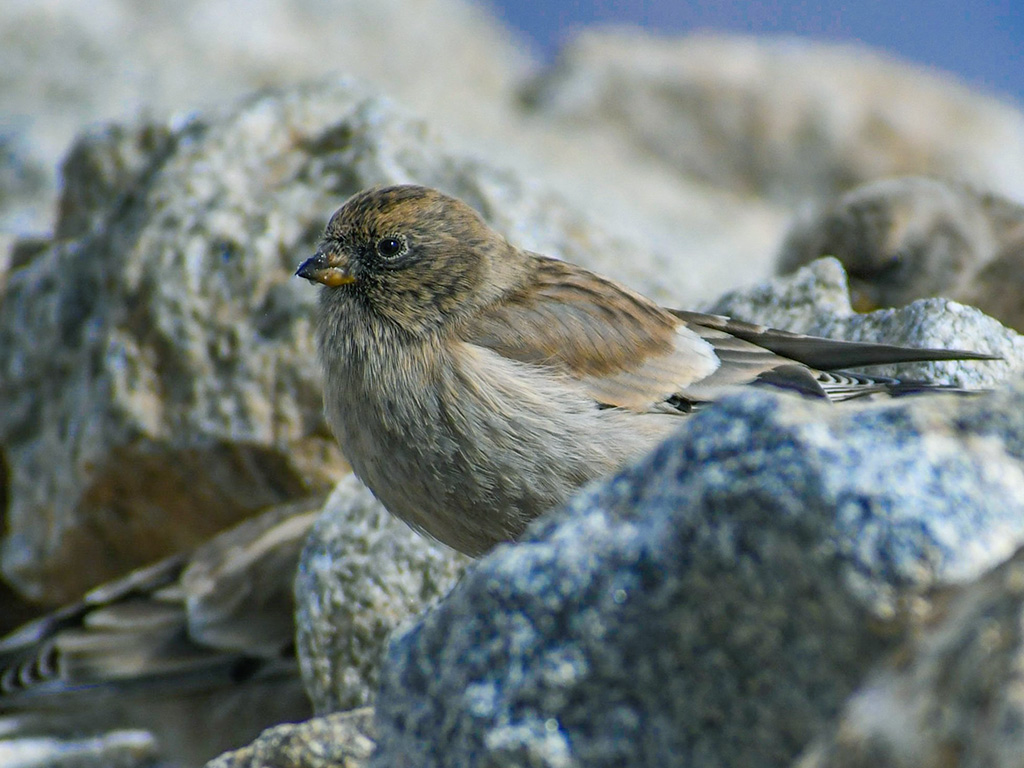
Brandt’s mountain finch, also called the black-headed mountain-finch, is a member of the Fringillidae family.
This type of bird lives in temperate grasslands located in areas such as Afghanistan, Bhutan, China, India, Kazakhstan, Nepal, Pakistan, Russia, Tajikistan, and Turkmenistan.
The bird is recognizable for its distinct black head, and it is relatively small overall. It has a unique appearance and is a common sight in its natural habitat.
Brandt’s mountain finch feeds primarily on seeds and insects, which it finds in its temperate grassland environment.
The bird is well-suited for life in its grassland habitat and is well-adapted to the conditions it faces there.
Overall, Brandt’s mountain finch is an interesting and important part of the local ecosystem where it lives.
Scientific classification:
| Kingdom | Animalia |
| Phylum | Chordata |
| Class | Aves |
| Order | Passeriformes |
| Family | Fringillidae |
| Subfamily | Carduelinae |
| Genus | Leucosticte |
| Species | L. brandti |